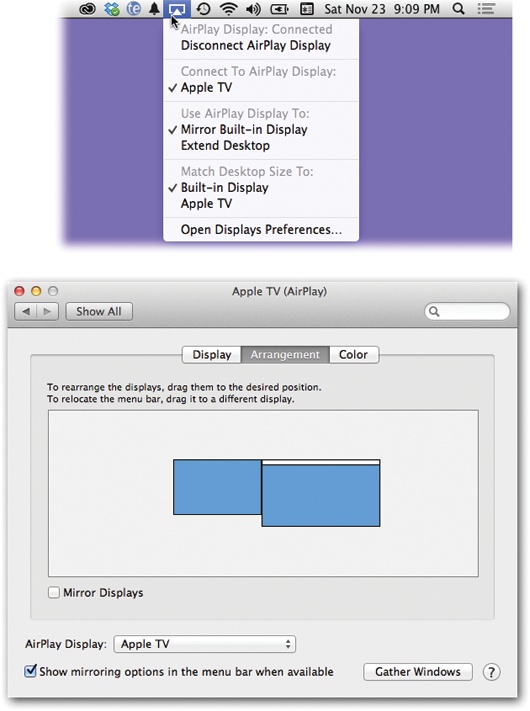Your Mac can use standard monitors of the type found in the Windows world. Every Macintosh can drive multiple screens at the same time, too, meaning that you can generally use your old PC screen either as your Mac’s main monitor or as a second, external screen.
If one of those arrangements appeals to you, the only complication might be the connector. Most PC screens, of course, have a standard VGA connector (or a more modern DVI connector) at the tip of their tails. Over the years, however, Apple has “standardized” on enough different screen-plug types to fill a catalog. There’s been DVI, Mini-DVI, Micro-DVI, Mini DisplayPort, Thunderbolt—you get the idea.
For the proper fee, Apple will be happy to sell you whatever adapter cable you need to accommodate the monitor you’ve got.
Tip
It’s even possible to connect both your Mac and your PC to the same monitor, and to switch from one to the other at will. If this arrangement appeals to you, you’ll need a so-called KVM switch (which also lets you switch your keyboard and mouse between the two computers). You can find KVM switches for sale at electronics stores and online from manufacturers like Belkin (www.belkin.com).
In any case, the center of operations for all your monitor settings is the System Preferences→Displays panel. Here you set your monitor’s resolution, calibrate color balance and brightness, and turn AirPlay on and off—a cool feature that duplicates whatever is on your Mac screen on a TV set. Wirelessly.
Tip
You can open up this panel with a quick keystroke from any program on the Mac. Just press Option as you tap one of the screen-brightness keys on the top row of your keyboard.
The specific controls depend on the kind of monitor you’re using, but here are the ones you’ll most likely see.
This tab is the main headquarters for your screen controls. It governs these settings:
Resolution. All Mac screens today can make the screen picture larger or smaller, thus accommodating different kinds of work. You perform this magnification or reduction by switching among different resolutions (measurements of the number of dots that compose the screen).
When you use a low-resolution setting, such as 800 x 600, the dots of your screen image get larger, thus enlarging (zooming in on) the picture—but showing a smaller slice of the page. Use this setting when playing a small Web movie, for example, so that it fills more of the screen. (Lower resolutions usually look blurry on flat-panel screens, though.) At higher resolutions, such as 1280 x 800, the screen dots get smaller, making your windows and icons smaller, but showing more overall area. You could use this kind of setting when working on two-page spreads in your page-layout program, for example.
If you select “Best for built-in display,” the Mac uses the highest resolution possible for your Mac’s screen—the one that makes it look sharpest. The list of other resolution settings your monitor can accommodate—800 x 600, 1024 x 768, and so on—doesn’t appear unless you turn on Scaled.
Brightness. This slider lets you make the screen look good in the prevailing lighting conditions. Of course, most Apple keyboards have brightness-adjustment keys, so this software control is included just for the sake of completeness.
Automatically adjust brightness. Your laptop’s light sensor dims the screen automatically in dark rooms—if this checkbox is turned on.
From the dawn of the color-monitor era, Macs have had a terrific feature: the ability to exploit multiple monitors all plugged into the computer at the same time. Sometimes you want the Mac to project the same thing on both screens (mirror mode); that’s useful in a classroom when the “external monitor” is a projector. Other times, you want to make one monitor act as an extension of the next. For example, you might have your Photoshop image window on your big monitor but keep all the Photoshop controls and tool palettes on a smaller screen. Your cursor passes from one screen to the other as it crosses the boundary.
To connect a second monitor or a projector, you have a couple of options:
The wired way. Connect the appropriate cable or adapter to your Mac’s video-output jack. This jack may be any of three types these days. Mac laptops and iMacs use a weird, tiny connector called a Mini DisplayPort; you need an adapter cord to connect it to the VGA, DVI, or HDMI input that most monitors or projectors expect.
All Macs these days also have something called Thunderbolt jacks. You can connect them to a few Thunderbolt-equipped external monitors, notably Apple’s.
Finally, there’s the black, cylindrical Mac Pro. It also has an HDMI jack, which is the easiest of all to connect to screens and projectors.
To set this up, hook up the monitor or projector. Your Mac should discover (and start projecting to) the external screen automatically; if it doesn’t, close and then reopen the lid (if you’re using a laptop), or choose Detect Displays from the Displays menulet.
Figure 9-20. Top: Use the
 menulet to control whether the TV displays a mirror image of your Mac or an extension of it. To stop sending your Mac’s A/V to your TV, choose Disconnect AirPlay Display from the same menulet. Bottom: Whenever two monitors are going, the Arrangement tab lets you specify which one gets the menu bar, and where the monitors think they are relative to each other.
menulet to control whether the TV displays a mirror image of your Mac or an extension of it. To stop sending your Mac’s A/V to your TV, choose Disconnect AirPlay Display from the same menulet. Bottom: Whenever two monitors are going, the Arrangement tab lets you specify which one gets the menu bar, and where the monitors think they are relative to each other.The wireless way. You can also connect your Mac to a TV wirelessly—if you have an Apple TV. This feature is called AirPlay, and it’s described on AirPlay.
Once you’ve connected a second screen, with a cable or without, a different System Preferences→Displays window appears on each screen. The idea is that you can change the color and resolution settings independently for each. Your Displays menulet shows two sets of resolutions, too—one for each screen.
The Arrangement tab (Figure 9-20, bottom) shows a miniature version of each monitor. By dragging these thumbnails around within the window, you can specify how you want the second monitor’s image “attached” to the first. Most people position the second monitor’s image to the right of the first, but you’re also free to position it on the left, above, below, or even directly on top of the first monitor’s icon (the last of which produces a video-mirroring setup). For the least likelihood of going insane, consider placing the real-world monitor in the same position.
For committed multiple-monitor fanatics, the fun doesn’t stop there. See the microscopic menu bar on the first-monitor icon? You can drag that tiny strip onto a different monitor icon, if you like, to tell Displays where you’d like your menu bar to appear. (And check out how most screen savers correctly show different stuff on each monitor!)
Tip
If you close your laptop while it’s connected to an external monitor, the machine doesn’t go to sleep. Instead, it keeps the external monitor on. The laptop remains on, so you can keep right on working, as though the laptop were the brains for a big-screen Mac.
When you’re not mirroring, here’s what you can expect:
The menu bar appears on every monitor. It’s bright and alive on only one screen at a time, though; on the other screens, it’s dimmed and unavailable until you click it.
The Dock appears on only one screen at a time. As you start working on a different screen, move your cursor to the bottom edge to make the Dock jump there. (That’s if you’ve positioned the Dock at the bottom. If you’ve placed it on the left or right, vertically, it stays on the leftmost or rightmost monitor all the time.)
Mission Control appears independently on every screen. That is, when you do the three-finger swipe upward, whatever programs are on each screen shrink down. You can even create separate sets of Spaces on each screen; it’s exactly as though you’re using multiple Macs and not just multiple screens.
This pane offers a list of color profiles for your monitor (or, if you turn off “Show profiles for this display only,” for all monitors). Each profile represents colors slightly differently—a big deal for design and photography types.
When you click Calibrate, the Display Calibrator Assistant opens to walk you through a series of six screens, presenting various brightness and color-balance settings in each screen. You pick the settings that look best to you; at the end of the process, you save your monitor tweaks as a ColorSync profile, which your Mac uses to adjust the screen for improved color accuracy.

